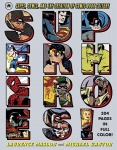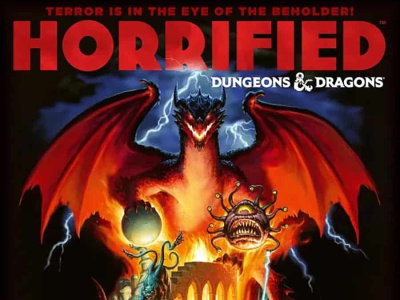 Superheroes! Capes, Cowls, and the Creation of Comic Book Culture HC
Superheroes! Capes, Cowls, and the Creation of Comic Book Culture HCPublisher: Crown Archetype
Release Date: October 1, 2013
Price: $40.00
Authors: Laurence Maslon and Michael Kantor
Format: 304 pgs., Full Color, Hardcover
ISBN: 9-780-3853-4858-4
Age Rating: All Ages
ICv2 Rating: 3 out of 5
It should be a warning for reviewers when the accompanying press release for any book hypes and promotes the associated television documentary more than the companion book itself. Regardless, while Laurence Maslon and Michael Kantor have produced a formidable synthesis of existing comics scholarship, there are glaring errors and omissions throughout that make it little more than an update to the already large canon of comics publishing histories.
Comic book histories are difficult books to review because they intentionally or unintentionally service far too many audiences. Comics scholars will often lambast a popular history such as Superheroes! for its failure to contextualize comics within a larger scope of popular culture media or social and cultural history in general, neglecting the fact that the book under review was not released by a university press such as the University Press of Mississippi with its outstanding catalog of comics scholarship. Fan reviewers at the host of various comics news sites throughout the Internet are mostly ignorant in evaluating any comics studies book as they possess little knowledge outside of comics to produce a balanced and informed critique. With Superheroes! the canvas is blurred further because it is the companion book to a three-hour PBS documentary on the topic and not a standalone work of comics scholarship. As an addendum to the series, Superheroes! suffers the same pitfalls as the PBS program--inch-deep, mile-wide analysis with sweeping and broad generalizations about comics' historical and cultural significance while simply regurgitating the same, stoic narrative fans have professed in print and in previous documentaries (History Channel's Comic Book Superheroes Unmasked in 2003) for years. If, instead, evaluated solely as a book found on the shelves of the local Barnes & Noble store where it will likely appeal to greater audiences beyond the PBS demographic, then Superheroes!, despite its flaws, does make a significant contribution to popular knowledge about the comics industry.
In several ways, Superheroes! as a book opens itself up to greater criticism for its omissions or missed opportunities than that of the PBS documentary. While both gloss over the mistreatment of early creators, referencing only and rather briefly the already well-travelled Siegel and Shuster legal battles, the book acknowledges the lucrative publishing contracts provided by newspaper syndicates for artists such as Alex Raymond that allowed many cartoonists to become millionaires in a decade where the Great Depression destroyed economic opportunities for millions of people, the same examination is not applied to comics. Since the book spends a considerable amount of time focusing on the newspaper and pulp precursors that shaped the inevitable rise of Superman in 1938's Action Comics, the absence of information on the production mentality behind and compensation for comics is disappointing.
Also, like the documentary, Superheroes! presents the spandex characters and their books not only in historical and cultural vacuums, but also disconnected from other trends in comics publishing outside the narrow parameters of the superhero genre. For instance, the "soft" analysis of what comics tell us about the Great Depression or the Cold War falls short when one examines the inclusion of scholarly books in Superheroes! bibliography and the growing field of comics scholarship. Comics are not just reflections of their era--how were they innovators and imitators throughout the decades and why is that significant? Nowhere is this pondered or addressed despite the repeated calls for superheroes' place as our modern mythologies. In fact, that trope is trotted out again and again in both the film and book as the sole justification for the genre's importance. Superheroes!'s march through time allows for no critical insight or perspective, and thus overlooks how underground, adult, or alternative comics were reactions to or against the superhero genre, as well as their influence upon it in later decades.
Furthermore, the organization and disjointed nature of the book's final chapters on the period from 1970 to the present render it as little more than a laundry list of events. The absence of any discussion of Amazing Heroes or Wizard magazine and the barely single page on comics fandom, comic conventions, and the rise and fall of the local comics store and direct market industry negates any of the book's credibility regarding the creation of comic book culture. While recent blockbusters are highlighted for their multi-billion dollar success stories of bringing superheroes to wider audiences, Superheroes! completely ignores the advent of digital distribution in any form. The arrival of Image Comics suddenly appears completely out of the blue and no efforts are made at making larger connections with creators' rights efforts within comics history. Although the authors include a quote from Gerry Conway about the hollywoodization of comics, there is no information on the effects of corporate ownership and how it has shaped the modern comics landscape for creators and audiences. Most alarming, however, are the dropped-in segments on race, gender, and sexuality. Again, if you have read any book by Les Daniels on the industry, you have heard it all before in its brief, encapsulated glory. Although there are many other glaring omissions and criticisms, the misidentification of Neil Gaiman as Frank Miller on page 224 in the "three influential comic book creators" photo montage with Alan Moore and Grant Morrison is inexcusable.
Yet, for all its faults, Superheroes! does succeed as a popular synthesis of recent scholarship. For example, the extensive bibliography is a solid mixture of commercial and academic publications on comics and throughout the text, scholars such as Bradford Wright and Amy Kiste Nyberg are quoted and sourced. This alone sets it apart from similar efforts by Les Daniels, Paul Levitz, Tom DeHaven, and Larry Tye.
--Nathan Wilson







